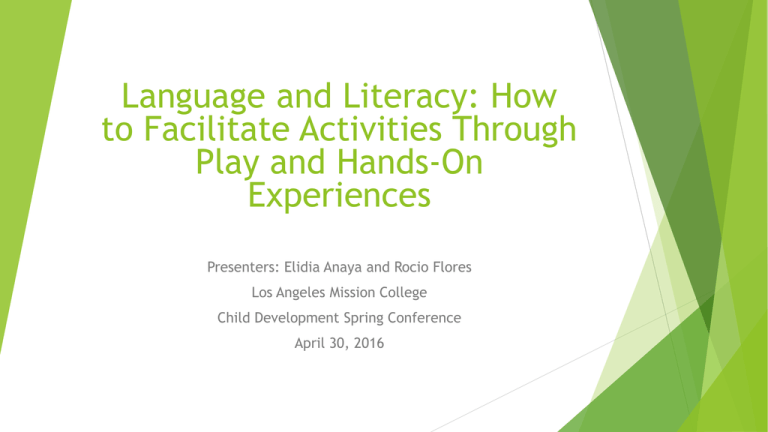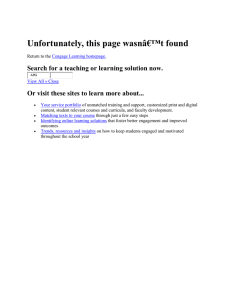
Language and Literacy: How
to Facilitate Activities Through
Play and Hands-On
Experiences
Presenters: Elidia Anaya and Rocio Flores
Los Angeles Mission College
Child Development Spring Conference
April 30, 2016
Language
Defined as human speech, written symbols
for speech, or any means of communicating
Development follows a predictable sequence
Related to chronological age
Includes both sending and receiving
information
Learned through use
Brain sets up circuitry needed to understand
and reproduce language
First 5-7 years is sensitive period
©2015 Cengage Learning. All Rights Reserved.
Language Development
of Young Children
Baby’s cry (birth to three months):
Cooing (0-3 months):
Some smile in their sleep, possibly through inner motivation.
Babbling (four to six months):
Sounds made by an infant when his/her needs are met.
Smiling and laughing (birth to three months):
Communicates hunger, discomfort, or fear.
Random sounds alternating constants and vowel sounds.
Association (six to nine months):
Begins to have an idea of the meaning of a few words.
©2015 Cengage Learning. All Rights Reserved.
Language Development
of Young Children
One-word usage (twelve months):
Recall (seven to twelve months):
Ability to remember an object named even when the object is
not visible is helped by touching, grasping, and tasting of the
object.
Telegraphic speech (one to two years):
Many first words are completely original, private words of the
child.
Two word sentences
Multiword speech (three to four years):
Stage of adult like speech with longer sentences and almost all
words present.
©2015 Cengage Learning. All Rights Reserved.
Language Development
of Young Children
By eighteen months uses at least 20 words and understands one
to word phrases
By twenty-four months uses at least 50 words and understands
200-500 words
By thirty six months uses at least 300 words and understands
simple questions
By forty eight months uses four to six word sentences and
understands why questions
By sixty months uses complete sentences and understands
instructions containing sequencing words
Information from: Learning to talk talking to learn,
http://www.talkingpoint.org.uk/sites/talkingpoint.org.uk/files/stagesspeech-language-development-chart001.pdf
©2015 Cengage Learning. All Rights Reserved.
Open Ended Questions
Questions that have more than one right answer, or can be answered in
many ways, are called open-ended questions. This way of asking questions
stimulates more language use, acknowledges that there can be many
solutions to one problem, affirms children’s ideas, and encourages creative
thinking.
What does this make you think of?
In what ways are these different?
In what ways are they the same?
What materials did you use?
What would happen if…?
What might you try instead?
Tell me about your…
What does it look like?
©2012 Cengage Learning.
All Rights Reserved.
Open Ended Questions
Connections Project; Learning Communities for All Children,
California Institute on Human Services, Sonoma State
University
What does it remind you of?
What does it feel like?
What can you do next time?
What can you tell me about it?
Tell me what happened.
What could you have done instead?
What do you feel, see, hear, taste, and smell?
How did you do that?
Is there anything else you could do/use?
What will you do next after you finish that?
How do you know?
Which one do you have more of?
What are some different things you could do?
Is one object longer/shorter than the other?
What is made of?
What do you call the things you are using?
Tell me what it looks like.
How are you going to do that?
Show me what you could do with it.
©2012 Cengage Learning.
All Rights Reserved.
Emergent Literacy
Process of developing
awareness about
reading and writing
before children can
actually read or write
Building blocks for
later reading, writing,
and communicating
Includes phonological
awareness and letter
recognition
©2015 Cengage Learning. All Rights Reserved.
Literacy Development of
Young Children
Components
Listening
Speaking
Reading
Writing
©2015 Cengage Learning. All Rights Reserved.
Literacy Development of
Young Children
Circular
Through play
Phonics
Is the relationship between the letters of the
written language and the sounds of the
spoken language.
Phonemes
The smallest unit of speech helping them
write the letter- sound relationship
©2015 Cengage Learning. All Rights Reserved.
Literacy Development of
Young Children
Phonological awareness
Rhyming
Two words that end the same way.
Vocabulary
The ability to hear and identify individual
sounds and spoken language.
The words we must know to communicate
Ideas for creating a developmentally
appropriate language and literacy
environment
©2015 Cengage Learning. All Rights Reserved.
National Institute for
Literacy
Knowing the names of printed letters
Knowing the sounds associated with printed
letters
Manipulating the sounds of spoken language
Rapidly naming a sequence of letters,
numbers, objects, or colors
Writing one’s own name or even isolated
letters
Remembering the content of spoken language
for a short time
©2015 Cengage Learning. All Rights Reserved.
Author and Illustrator Activities
With your group create a story
Each of you will create a page of
the story and illustrated
Put the book together and share it
©2012 Cengage Learning.
All Rights Reserved.
Dot Painting Names
Write you name on the butcher
paper
Use dot markers to decorate your
name
©2012 Cengage Learning.
All Rights Reserved.
Playdough Letters
Make letters with playdough
©2012 Cengage Learning.
All Rights Reserved.
Pipe Cleaner Words
Form letters with the pipe
cleaners to create a word
©2012 Cengage Learning.
All Rights Reserved.
Matching Word Cards
Match the words
©2012 Cengage Learning.
All Rights Reserved.
Books
Read a book
Come up with three why questions
Come up with three how questions
Three vocabulary words
©2012 Cengage Learning.
All Rights Reserved.
Pinky Promise
©2012 Cengage Learning.
All Rights Reserved.





